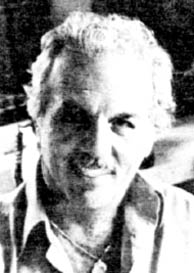
Joe Palooka is an American comic strip about a heavyweight boxing champion, created by cartoonist Ham Fisher. The strip debuted on April 19, 1930 and was carried at its peak by 900 newspapers. It was cancelled in 1984.

Hammond Edward "Ham" Fisher was an American comic strip writer and cartoonist. He is best known for his long, popular run on Joe Palooka, which was launched in 1930 and ranked as one of the top five newspaper comics strips for several years.

Leonard Starr was an American cartoonist, comic book artist, and advertising artist, best known for creating the newspaper comic strip On Stage and reviving Little Orphan Annie.

A topper in comic strip parlance is a small secondary strip seen along with a larger Sunday strip. In the 1920s and 1930s, leading cartoonists were given full pages in the Sunday comics sections, allowing them to add smaller strips and single-panel cartoons to their page.
Notable events of 1936 in comics.

Flemming Andersen is a Danish comics artist best known for Disney comics starring Donald Duck and related characters. He is also doing his own comic strip A Seagull's Life.

Mickey Finn was an American comic strip created by cartoonist Lank Leonard, which was syndicated to newspapers from April 6, 1936 to September 10, 1977. The successful lighthearted strip struck a balance between comedy and drama. It was adapted to a 400-page Little Big Book and was reprinted in several comic book series throughout the 1930s and 1940s.

Feature Comics, originally Feature Funnies, was an American comic book anthology series published by Quality Comics from 1939 until 1950, that featured short stories in the humor genre and later the superhero genre.

Frank Springer was an American comics artist best known for Marvel Comics' Dazzler and Nick Fury, Agent of S.H.I.E.L.D.. As well, in collaboration with writer Michael O'Donoghue, Springer created one of the first adult-oriented comics features on American newsstands: "The Adventures of Phoebe Zeit-Geist" in the magazine Evergreen Review. A multiple winner of the National Cartoonists Society's Reuben Award, Springer was a president of the Society and a founding member of the Berndt Toast Gang, its Long Island chapter.
Anthony Louis DiPreta was an American comic book and comic strip artist active from the 1940s Golden Age of comic books. He was the longtime successor artist of the comic strip Joe Palooka (1959–84) and drew the Rex Morgan, M.D. daily strip from 1983 until DiPreta's retirement in 2000.

Fontaine Talbot Fox Jr. was an American cartoonist and illustrator best known for writing and illustrating his Toonerville Folks comic panel, which ran from 1913 to 1955 in 250 to 300 newspapers across North America.

Francis A. "Fran" Matera was an American comic strip artist best known for his King Features Syndicate adventure strip Steve Roper and Mike Nomad from 1984 to 2004. In addition to his extensive experience in newspaper strips, Matera also spent many years in the comic book industry, particularly for Charlton Comics. His influences include Hal Foster, Alex Raymond, Milton Caniff, Al Capp, and Bud Fisher.

Famous Funnies is an American comic strip anthology series published from 1934 to 1955 with two precursor one-shots appearing in 1933–1934. Published by Eastern Color Printing, Famous Funnies is considered by popular culture historians as the first true American comic book, following seminal precursors.

Columbia Comics Corporation was a comic book publisher active in the 1940s whose best-known title was Big Shot Comics. Comics creators who worked for Columbia included Fred Guardineer, on Marvelo, the Monarch of Magicians; and Ogden Whitney and Gardner Fox on Skyman.

The McNaught Syndicate was an American newspaper syndicate founded in 1922. It was established by Virgil Venice McNitt and Charles V. McAdam. Its best known contents were the columns by Will Rogers and O. O. McIntyre, the Dear Abby letters section and comic strips, including Joe Palooka and Heathcliff. It folded in September 1989.

Frank E. Leonard, better known as Lank Leonard, was an American cartoonist artist who created the long-running comic strip Mickey Finn, which he drew for more than three decades.

Jerry Weiss is an American figurative, landscape, and portrait painter and a writer. He studied classical drawing, and his career has centered on both the figure, and landscape. He says he is "intrigued by the portrait and figure as a most sacred subject."
Leonard James Matthews was a British editor, publisher, writer and illustrator of comics and children's magazines, best known as the founder of the educational magazine Look and Learn.

Scribbly the Boy Cartoonist is a comic book character created in 1936 by Sheldon Mayer, first appearing in Dell Comics and then moving to All-American Publications. Scribbly Jibbet is a semi-autobiographical character, presenting the adventures of a young man starting out in the cartooning business, and working for the Morning Dispatch newspaper. His stories were told around the Golden Age era, when American comic books were primarily anthologies telling more than one story in a magazine issue. Scribbly first appeared in the Popular Comics series, and then appeared in All-American Comics from 1939 to 1944. He was then revived in his own series, Scribbly, from 1948 to 1952.
















